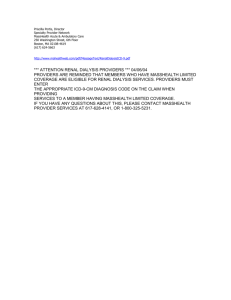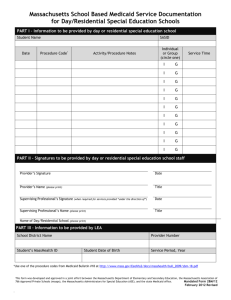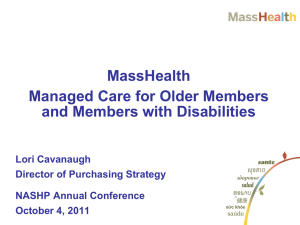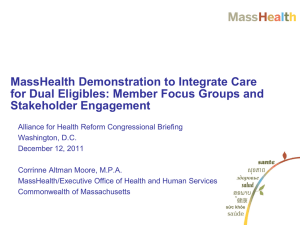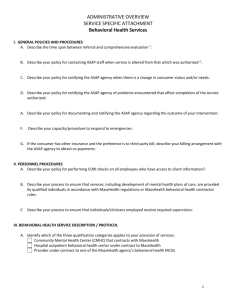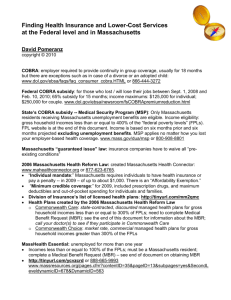masshealth: the basics - Center for Health Law and Economics
advertisement
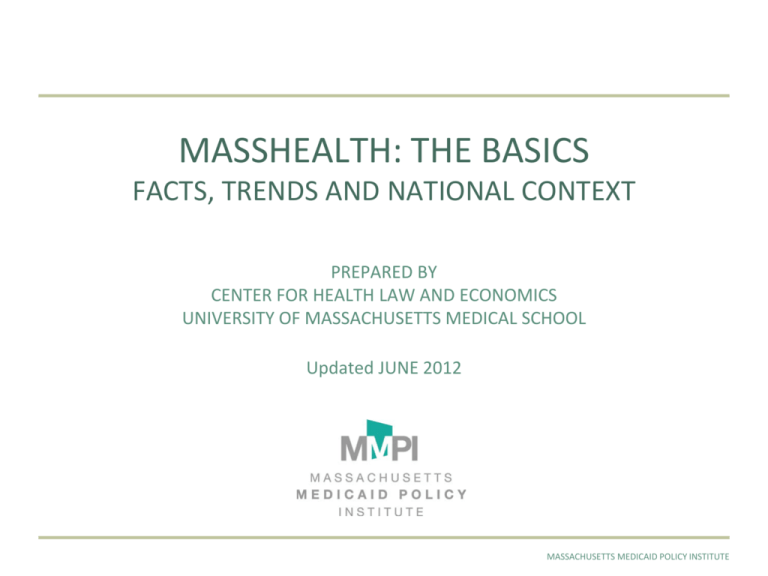
MASSHEALTH: THE BASICS FACTS, TRENDS AND NATIONAL CONTEXT PREPARED BY CENTER FOR HEALTH LAW AND ECONOMICS UNIVERSITY OF MASSACHUSETTS MEDICAL SCHOOL Updated JUNE 2012 JUNE 2012 MASSACHUSETTS MEDICAID POLICY INSTITUTE TABLE OF CONTENTS EXECUTIVE SUMMARY 2 INTRODUCTION 4 ELIGIBILITY AND ENROLLMENT 5 SPENDING 19 COST DRIVERS 25 CONCLUSIONS 29 JUNE 2012 MASSACHUSETTS MEDICAID POLICY INSTITUTE 1 MASSHEALTH: THE BASICS EXECUTIVE SUMMARY MassHealth is an essential health safety net for more than 1.3 million of the state’s adults and children The Massachusetts Medicaid program (commonly referred to as “MassHealth”) provides health insurance to nearly one-fifth of Massachusetts residents. More than half of people with disabilities, more than half of children of low-income families, and two-thirds of residents of nursing facilities rely on MassHealth to help them pay for health care. One-third of all births are covered by MassHealth. JUNE 2012 MassHealth covers a broad cross-section of the population MassHealth supports workers’ access to private insurance While most members are children and adults without disabilities, who represent three-fifths of total MassHealth membership, adults and children with disabilities comprise 20 percent of MassHealth members, and seniors make up another 11 percent. Nearly two-thirds of the program's spending is for the care of members with disabilities and for seniors. For nearly one-quarter of its members, MassHealth coverage is secondary to other insurance such as Medicare or employersponsored insurance. MassHealth benefits help make employeroffered insurance more affordable for eligible low-wage workers and their children by paying for the employee share of the premium and by covering most of the cost of copayments and deductibles. In addition, MassHealth benefits make it possible for many people with disabilities to remain in the workforce. MassHealth offers eligibility to a broader segment of the Massachusetts population than many other states’ Medicaid programs. In particular, more people with disabilities qualify through the state’s CommonHealth program, which offers benefits to persons with disabilities that are not generally available through employers or Medicare. But this does not mean that MassHealth covers an unusually high portion of the Massachusetts population when compared to other states, because of the high rate of employer-sponsored insurance and higher incomes in Massachusetts. MASSACHUSETTS MEDICAID POLICY INSTITUTE 2 MASSHEALTH: THE BASICS EXECUTIVE SUMMARY (continued) Growing MassHealth enrollment has accompanied the decline in the number of uninsured; however, most of the increase in MassHealth enrollment would have occurred in the absence of Massachusetts health reform MassHealth already covered a million adults and children in Massachusetts when the state’s health reform law was enacted in 2006. Enrollment growth in the several categories of eligibility that were expanded or restored by health reform represents only a quarter of overall growth in MassHealth membership since implementation of reform began. The biggest driver of MassHealth spending in recent years has been the jump in MassHealth members due to the recession, not the amount spent for each member Spending in the program has grown, driven by increases in enrollment due to the economic downturn. Per capita spending has grown by an average of just 1 percent per year in the past 5 years. JUNE 2012 MassHealth spending trends reflect policy toward providing more care in community-based settings and less in facilities and inpatient settings In the past three fiscal years, spending on nursing facility and hospital inpatient care declined slightly while a substantial portion of growth in spending was attributable to increased spending on community based long term support services. MassHealth is an important source of income for physicians, hospitals and other providers that low-income and uninsured individuals of all ages depend on for their care. Community health centers and nursing homes receive at least half of their total patient revenues from MassHealth. MASSACHUSETTS MEDICAID POLICY INSTITUTE 3 INTRODUCTION MASSHEALTH OVERVIEW ELIGIBILITY AND ENROLLMENT SPENDING COST DRIVERS CONCLUSIONS MassHealth is Medicaid (Title XIX of the Social Security Act) and the State Children’s Health Insurance Program (CHIP, Title XXI) Federal- and state-funded and state-administered A central part of the Massachusetts health care safety net – MassHealth provides health care coverage to the Commonwealth’s most vulnerable residents. – It pays providers for treatments that would otherwise go uncompensated, or not provided at all. – It provides a valuable service to employers by covering some of the highest costs of their employees and dependents with disabilities. – It brings billions of federal dollars into the state to help finance physical and behavioral health care and longterm care for low-income people. – It is the financial engine for the publicly subsidized insurance expansion created by the 2006 state health reform law, which greatly expanded coverage in Massachusetts. – It is countercyclical, playing an important role in supporting people who are affected by economic downturns. MASSHEALTH PRESENTS CHALLENGES It requires a great amount of public funding to support it. Many of its benefits and eligibility provisions are legal entitlements, which constrains the state’s options for managing spending during difficult economic times. Change is imminent as policy changes focus more on delivery system improvement and cost containment, and the national health reform law goes into effect. THE FOLLOWING CHARTS Present an overview of MassHealth eligibility, enrollment and spending, providing national comparisons where possible. – Interstate comparisons are offered to provide perspective and should be interpreted with caution. Every state’s Medicaid program is unique – eligibility criteria, services, reliance on managed care, and use of waivers for special or general populations vary by state. Broad conclusions based on these comparisons are not advised. Demonstrate that MassHealth – Provides health insurance that is an essential gateway to health care for one-fifth of the Massachusetts population; – Is an important source of income for providers who serve low income patients; and – Compares favorably to private insurance in controlling per capita cost increases. JUNE 2012 MASSACHUSETTS MEDICAID POLICY INSTITUTE 4 ELIGIBILITY AND ENROLLMENT INTRODUCTION SPENDING COST DRIVERS CONCLUSIONS MASSHEALTH ELIGIBILITY OVERVIEW CHILDREN % of FPL* 300% ADULTS UNDER 65 NO UPPER LIMIT 300% 200% 185% 200% 185% 150% 133% 150% 133% 100% 86% 100% 86% 0 1-5 6-14 15-17 18 Pregnant Disabled NO UPPER LIMIT Pregnant Disabled AGE IN YEARS COVERAGE BY EXPANSION Base Population (eligible before 7/97) Expansion 7/97, SCHIP if child and uninsured CommonHealth 7/97 (formerly state-funded program) Expansion 7/97, SCHIP if uninsured Expansion 1/99, 1/00, Premium Assistance Expansion 4/01, Family Assistance Expansion 7/06, 10/06 Commonwealth Care, 10/06** HIV Positive Work All Work Long-Term All for Other for Unemployed Other Qualified Qualified Employer Employer (Insurance (Insurance Partnership) Partnership) WITH CHILDREN UNDER AGE 19 WITHOUT CHILDREN UNDER AGE 19 *FPL = federal poverty level **Commonwealth Care excludes employed people whose employers offer coverage. Undocumented immigrants are not eligible either for MassHealth (except for limited emergency coverage) or for Commonwealth Care. NOTE: In general, the eligibility level for seniors age 65 and older is 100% of FPL and assets of up to $2,000 for an individual or $4,000 for a couple. More generous eligibility rules apply for seniors residing in nursing facilities or enrolled in special waiver programs. There is no income limit for seniors who need long-term services, but an individual contribution may be required. JUNE 2012 MASSACHUSETTS MEDICAID POLICY INSTITUTE 5 INTRODUCTION ELIGIBILITY AND ENROLLMENT SPENDING COST DRIVERS CONCLUSIONS MANY DOORS TO MASSHEALTH Individual applies directly, either on paper form or through Virtual Gateway Health care providers assist uninsured patients with applications through Virtual Gateway • • • • NOTE: The Virtual JUNE 2012 Hospitals Community health centers Nursing homes Other providers State social services agencies facilitate applications • Department of Developmental Services • Department of Mental Health • Mass. Rehabilitation Commission • Department of Transitional Assistance • Department of Children and Families • Other agencies Gateway is a web-based tool that includes applications for MassHealth and other Massachusetts programs. Community organizations and advocacy groups that provide health care referrals or other services assist clients with applications and follow-up • Community action programs • Community development corporations • Aging services access points • Health Care For All • Other community organizations MASSACHUSETTS MEDICAID POLICY INSTITUTE 6 INTRODUCTION ELIGIBILITY AND ENROLLMENT SPENDING COST DRIVERS CONCLUSIONS MASSHEALTH IS IMPORTANT TO MANY POPULATION GROUPS PERCENT OF SELECT MASSACHUSETTS POPULATIONS COVERED BY MASSHEALTH, 2010 All non-elderly adults 15% Non-elderly adults earning <300%FPL 37% Non-elderly adults earning <100%FPL 47% All children 37% Children in families earning <300%FPL 59% Children in families earning <100%FPL 73% Births (child born in last 12 months) 33% Medicare beneficiaries 27% People with disabilities (require assistance with self-care) 59% Nursing home residents Nearly three-quarters of of poor (<100% FPL) children and more than half of nearpoor children (100-300% FPL), half of poor adults and people with disabilities, and nearly two-thirds of nursing home residents are MassHealth members. One-quarter of people covered by Medicare rely on MassHealth to assist with premiums and cost sharing and to cover services, such as long-term services and supports, which Medicare does not cover. 63% 0% 10% 20% 30% 40% 50% 60% 70% 80% SOURCES: Author’s calculations using the 2010 American Community Survey (ACS). Nursing home data from Kaiser State Health Facts (C. Harrington, H. Carrillo, M. Dowdell, P. Tang, and B. Blank. Table 6, "Nursing, Facilities, Staffing, Residents, and Facility Deficiencies, 2005 Through 2010," Department of Social and Behavioral Sciences, University of California, San Francisco, accessed January 2012). Data for “all children” and “all elderly adults” calculated from Census 2010 population data and MassHealth Snapshot report, 2010 monthly average. JUNE 2012 MASSACHUSETTS MEDICAID POLICY INSTITUTE 7 ELIGIBILITY AND ENROLLMENT INTRODUCTION SPENDING COST DRIVERS CONCLUSIONS INCOME ELIGIBILITY LEVELS FOR MASSHEALTH ARE CURRENTLY HIGHER THAN NATIONAL MEDIAN ELIGIBILITY LEVELS BY CATEGORY, MASSHEALTH AND MEDIAN U.S., 2012 37% Non-working parents 133% Starting in 2014, all states will be required to provide Medicaid coverage to adults with incomes at or below 133% FPL. U.S. MASSACHUSETTS 63% Working parents 133% 80% Seniors and disabled (2009 Data) SENIORS 100% DISABLED 185% Pregnant women 200% 250% Children 0% 50% 100% 150% 200% 300% 250% In Massachusetts, as opposed to most other states, there is no income eligibility limit for people with disabilities. The CommonHealth program offers MassHealth coverage, subsidized at lower incomes and with a sliding scale premium as incomes rise. 300% INCOME RELATIVE TO FEDERAL POVERTY LEVEL SOURCE: All but Seniors and Disabled, based on the results of a national survey conducted by the Kaiser Commission on Medicaid and the Uninsured and the Georgetown University Center for Children and Families, 2012. Seniors and disabled: 2009 data from Kaiser statehealthfacts.org JUNE 2012 MASSACHUSETTS MEDICAID POLICY INSTITUTE 8 ELIGIBILITY AND ENROLLMENT INTRODUCTION SPENDING COST DRIVERS CONCLUSIONS MASSHEALTH COVERS CHILDREN, ADULTS & SENIORS, AND OFTEN SUPPLEMENTS OTHER INSURANCE PERCENT OF TOTAL MASSHEALTH ENROLLMENT, MARCH 2012 LT Unemployed Adults – 127,586 Seniors in Nursing Facilities – 24,798 Seniors in Community – 91,164 Other – 22,416 2% 10% 2% Non-Disabled Children – 517,176 7% 39% Adults with Disabilities – 228,195 17% 2% 22% Non-Disabled Adults – 300,738 SOURCE: MassHealth, JUNE 2012 Children with Disabilities – 30,052 MassHealth members range from the very young to the very old. Members with disabilities, representing 19 percent of membership, receive coverage for long-term care services from MassHealth that are not usually available through other health insurance sources. About 24 percent of people enrolled in MassHealth have coverage through Medicare or through an employer. In these cases, MassHealth acts as secondary coverage, providing additional benefits that MassHealth covers but others do not. In some circumstances, MassHealth also pays members’ premiums and cost sharing for their employer-sponsored or Medicare coverage, if it is determined to be more economical than paying for full MassHealth benefits. March 2012 Snapshot report. MASSACHUSETTS MEDICAID POLICY INSTITUTE 9 INTRODUCTION ELIGIBILITY AND ENROLLMENT SPENDING COST DRIVERS CONCLUSIONS COMPARED TO THE REST OF THE NATION, MASSHEALTH’S MEMBERSHIP INCLUDES MORE ADULTS AND NON-ELDERLY PEOPLE WITH DISABILITIES MASSACHUSETTS, 2011 People with disabilities comprise a larger share of Medicaid membership in Massachusetts than nationally. Adults without disabilities qualify in Massachusetts at higher income levels that are typical in other states. U.S., FFY 2009 10% 9% 15% 20% 39% 49% 26% 32% Non-Disabled Children SOURCES: MassHealth JUNE 2012 Non-Disabled Adults Adults & Children with Disabilities MassHealth CommonHealth provides opportunity for more people with disabilities to get coverage. Seniors make up about the same portion of Medicaid enrollment in Massachusetts and the nation. Seniors Snapshot Report, monthly averages for CY 2011; Kaiser Commission on Medicaid and the Uninsured. MASSACHUSETTS MEDICAID POLICY INSTITUTE 10 INTRODUCTION ELIGIBILITY AND ENROLLMENT SPENDING COST DRIVERS CONCLUSIONS MASSHEALTH PLAYS A SIGNIFICANT BUT NOT DISPROPORTIONATE ROLE IN THE COVERAGE OF MASSACHUSETTS RESIDENTS PERCENTAGE OF POPULATION ENROLLED IN MEDICAID, 2010 35% 30% 25% 20% 15% 10% Despite its much lower uninsured rate and higher Medicaid eligibility standards than many other states, MassHealth does not cover an unusually high percentage of the state population. Massachusetts has relatively high incomes and a high rate of employer-sponsored insurance. In addition, MassHealth has generally been more successful than many other states in ensuring those eligible for Medicaid are enrolled. 0% US ND UT NJ VA NH KS NV CO MT NE WY SD ID OR IA MO MN TX MD AK NC SC IN CT FL GA WA RI OK WI AL PA OH HI MA WV KY AR AZ IL CA MI TN MS ME LA DE VT NM NY DC 5% State SOURCES: Calculations based on Medicaid enrollment data from December 2010, Henry J. Kaiser Family Foundation, Statehealthfacts.org; Population estimates from the U.S. Census Bureau, Annual Estimates of the Resident Population for the United States, Regions, States, and Puerto Rico: April 1, 2010 to July 1, 2011 (NST-EST2011-01). JUNE 2012 MASSACHUSETTS MEDICAID POLICY INSTITUTE 11 ELIGIBILITY AND ENROLLMENT INTRODUCTION SPENDING COST DRIVERS CONCLUSIONS GROWING MASSHEALTH ENROLLMENT HAS ACCOMPANIED THE DECLINE IN THE NUMBER OF UNINSURED TRENDS IN MASSHEALTH ENROLLMENT AND UNINSURED, 1995-2011 (THOUSANDS) 1,400 1,301 1,200 983 1,000 911 1,024 1,077 1,124 MassHealth 1,161 1,235 928 851 800 655 683 600 496 400 365 418 460 395 355 Uninsured 120 200 165 171 2008 2009 0 1995 1998 2000 2002 2004 2006 2007 2010 2011 SOURCES: MassHealth figures are from the Office of Medicaid and are monthly averages, except 1998-2002 which are as of June 30. Uninsured numbers are from the Division of Health Care Finance and Policy, from a survey in that year. 1995 Uninsured numbers from Blendon et al., “Massachusetts Residents Without Health Insurance, 1995,” Harvard School of Public Health. 2011 uninsured numbers are not available. JUNE 2012 Since the MassHealth waiver began in 1997, MassHealth membership has steadily grown, and the number of Massachusetts residents without insurance has steadily declined since 2004. Commonwealth Care, introduced in 2007, has also played a role in recent declines in the number of uninsured. Most of the recent increase in MassHealth enrollment has been driven by the recession. Enrollment growth in categories of eligibility that were expanded under Massachusetts’ health reform law represented only a quarter of overall growth in MassHealth enrollment since implementation of reform. MASSACHUSETTS MEDICAID POLICY INSTITUTE 12 ELIGIBILITY AND ENROLLMENT INTRODUCTION SPENDING COST DRIVERS CONCLUSIONS MEDICAID ENROLLMENT HAS GROWN IN THE PAST DECADE, BOTH NATIONALLY AND IN MASSACHUSETTS U.S. AND MASSACHUSETTS MEDICAID ENROLLMENT GROWTH INDICIES (YEAR 2000 = 100) 170 U.S. 160 150 Massachusetts 140 130 120 110 Medicaid enrollment increased at a similar rate in Massachusetts and the U.S. between 2003 and 2010. The acceleration in growth in the U.S. since 2008 is due largely to the recession. Enrollment in Massachusetts did not grow as quickly during that period because employer-sponsored insurance did not decline as much as it did in the nation as whole. The trend slowed slightly in the second half of 2010. 100 2000 2001 2002 2003 2004 2005 2006 2007 2008 2009 2010 Dec-10 NOTE: The decline in Massachusetts enrollment in 2003 was due to the changes to the MassHealth Basic program that resulted in the disenrollment of thousands of members (many of whom were later reinstated to the MassHealth Essential program), and the tightening of requirements for the periodic redetermination of eligibility. SOURCE: Kaiser Commission on Medicaid and Uninsured, “Medicaid Enrollment: December 2010 Data Snapshot,” December 2011. June data for all years, except final data point. JUNE 2012 MASSACHUSETTS MEDICAID POLICY INSTITUTE 13 INTRODUCTION ELIGIBILITY AND ENROLLMENT SPENDING COST DRIVERS CONCLUSIONS ENROLLMENT IN MEDICAID ACCELERATED DURING THE RECENT RECESSION U.S. AND MASSACHUSETTS PERCENTAGE GROWTH IN MEDICAID ENROLLMENT 9% MA % Change in MassHealth Enrollment U.S. % Change in Medicaid Enrollment 8% 7% 6% 5% 4% 7.8% 3% 5.6% 7.2% 5.0% 2% 3.1% 4.0% 3.1% 1% 2.3% 0% June 2007 to June 2008 SOURCE: June 2008 to June 2009 June 2009 to June 2010 June 2010 to Dec 2010 Enrollment in Medicaid increased at a slower rate in Massachusetts than nationally during the height of the economic recession in June 2008 through June 2010. One possible explanation is that most people eligible for MassHealth were already enrolled. In addition, some people in Massachusetts who lost their private health insurance during the recession obtained coverage through other programs, such as Commonwealth Care (which serves adults with incomes <300% FPL who don’t have access to employer sponsored insurance) and the Medical Security Program (which subsidizes coverage for unemployed adults). The trend in the last half of 2010 suggests a slowing of the recession-driven increases in Medicaid enrollment on a national level. Kaiser Commission on Medicaid and the Uninsured, “Medicaid Enrollment: December 2010 Snapshot,” December 2011. JUNE 2012 MASSACHUSETTS MEDICAID POLICY INSTITUTE 14 ELIGIBILITY AND ENROLLMENT INTRODUCTION SPENDING COST DRIVERS CONCLUSIONS GROWTH IN MASSHEALTH ENROLLMENT HAS BEEN PRIMARILY IN CATEGORIES THAT WERE NOT EXPANDED UNDER REFORM 252,000 76% 190,000 MassHealth eligibility categories not affected by Chapter 58 24% 61,000 Chapter 58 MassHealth expansion categories Most (76 percent) of MassHealth enrollment growth has been in eligibility categories that existed before health reform, and therefore would have occurred in the absence of the state’s health reform law. MASSHEALTH ENROLLMENT GROWTH JUNE 2006 TO DECEMBER 2010 JUNE 2012 MASSACHUSETTS MEDICAID POLICY INSTITUTE 15 ELIGIBILITY AND ENROLLMENT INTRODUCTION SPENDING COST DRIVERS CONCLUSIONS MORE THAN THREE IN FIVE MASSHEALTH MEMBERS ARE ENROLLED IN MANAGED CARE MASSHEALTH ENROLLMENT BY PAYER TYPE, MARCH 2012 FFS 454,022 MCO 481,993 36% 34% 2% 29% SCO 20,559 PCC PLAN 385,551 SOURCE: MassHealth, JUNE 2012 For persons under age 65, MassHealth offers two options for managed care: enrolling in one of five private managed care organizations (MCOs), or in the MassHealth-administered Primary Care Clinician (PCC) Plan. Seniors may enroll in managed care via Senior Care Options (SCO). More than three in five Massachusetts residents enrolled in Medicaid have managed care through one of these three options. Those in fee for service (FFS) include seniors not enrolled in SCO, people with other coverage as primary (e.g., Medicare or employer sponsored insurance) and people who are permanently institutionalized. March 2012 snapshot report. MASSACHUSETTS MEDICAID POLICY INSTITUTE 16 INTRODUCTION ELIGIBILITY AND ENROLLMENT SPENDING COST DRIVERS CONCLUSIONS MANY OTHER STATES’ MEDICAID PROGRAMS RELY MORE THAN MASSACHUSETTS ON MANAGED CARE ARRANGEMENTS PERCENTAGE OF MEDICAID MEMBERS ENROLLED IN SOME FORM OF MANAGED CARE, 2010 100% 90% 80% 70% 71% 60% 54% 50% 40% 30% 20% 0% US SC TN MO HI CO GA AZ IA OK KY ID WA OR KS MI ND NV UT PA SD MD AR NB DE NJ MS MT OH NM IN CT DC NY ME RI ND TX FL MN LA WI AL VA VT IL CA MA WV AK NH WY 10% Managed care penetration in MassHealth is well below the national average for Medicaid programs. “Managed care arrangement” includes primary care case management programs as well as managed care organization contracts and long term managed care contracts. In MassHealth, members for whom Medicaid is secondary to Medicare or employersponsored coverage are not enrolled in managed care (except for a relatively small number of seniors who opt to enroll in the Senior Care Options program). State NOTE: Managed care includes managed care organization and primary care case management models. In Massachusetts, managed care includes enrollees in private Managed Care Organizations (MCO), MassHealth’s Primary Care Clinician (PCC) program, and the Senior Care Options (SCO) program. Managed care percentage differs from preceding slide due to different time periods and data sources. SOURCES: Henry J. Kaiser Family Foundation, Statehealthfacts.org. JUNE 2012 MASSACHUSETTS MEDICAID POLICY INSTITUTE 17 ELIGIBILITY AND ENROLLMENT INTRODUCTION SPENDING COST DRIVERS CONCLUSIONS MCOs SERVE A LESS MEDICALLY COMPLEX POPULATION THAN THE PCC PLAN MASSHEALTH MCO AND PCC PLAN ENROLLMENT BY POPULATION TYPE, MARCH 2012 500,000 450,000 Total: 481,954 Basic/Essential Adults — 9% Total: 385,590 400,000 350,000 300,000 Non-disabled Adults — 26% Basic/Essential Adults — 20% Disabled Adults — 8% Non-disabled Adults — 20% 250,000 200,000 150,000 Disabled Adults — 15% Non-Disabled Children — 55% Non-Disabled Children — 41% 100,000 50,000 0 Disabled Children — 3% Disabled Children — 3% MCO PCC Plan TYPE OF MANAGED CARE NOTE: MassHealth members with disabilities and other medically complex care needs are generally more likely to enroll in the Primary Care Clinician (PCC) Plan rather than with an MCO. MCOs serve a less complex population – more than half are non-disabled children and a quarter are non-disabled adults. The PCC Plan, on the other hand, serves a population with more complex care needs — nearly 20 percent of PCC Plan enrollees are people with disabilities and 20 percent are long term unemployed (Basic/Essential) who are more likely to have behavioral health needs. Chart shows enrollment for members under age 65. MassHealth, March 2012 Snapshot Report. SOURCE: JUNE 2012 MASSACHUSETTS MEDICAID POLICY INSTITUTE 18 ELIGIBILITY AND ENROLLMENT INTRODUCTION SPENDING COST DRIVERS CONCLUSIONS NOMINAL MASSHEALTH SPENDING HAS GROWN BY ALMOST HALF SINCE 2005; WHEN ADJUSTED FOR MEDICAL INFLATION SPENDING GROWTH HAS BEEN 13 PERCENT MASSHEALTH SPENDING, SFY 2005-2011 (BILLIONS OF DOLLARS) $10 $9.1 $8.8 $9 Current Dollars $8.1 $8 $7.7 $6.8 $7 $7.0 $6.3 $6 $6.3 Inflation-adjusted Dollars $7.0 $6.5 $6.7 $6.7 2008 2009 $7.1 $6.4 MassHealth spending has increased in nominal terms from $6.3 billion in state fiscal year (SFY) 2005 to $9.1 billion in SFY 2011. Adjusting for medical inflation, the average annual increase over the sixyear period was approximately 2 percent. These are “gross” spending amounts, meaning that they include both state and federal revenues; the federal government reimburses Massachusetts for about half of its MassHealth spending. $5 2005 2006 2007 2010 2011 STATE FISCAL YEAR MassHealth Budget Office. Inflation adjustment uses the Medical Consumer Price Index for the Boston area, from the Bureau of Labor Statistics SOURCE: JUNE 2012 MASSACHUSETTS MEDICAID POLICY INSTITUTE 19 ELIGIBILITY AND ENROLLMENT INTRODUCTION SPENDING COST DRIVERS CONCLUSIONS FEDERAL AND STATE SPENDING ON MASSHEALTH NOW REPRESENTS 30 PERCENT OF THE STATE BUDGET MASSHEALTH AS A PROPORTION OF ALL STATE SPENDING (BILLIONS OF DOLLARS) $35 MassHealth-covered Services $30 $27.8 $23.5 $25 Other State Spending $28.9 $27.4 $21.2 $19.3 $17.2 $30.3 $25.4 $20 $15 $29.6 $18.6 $20.8 $20.9 $21.2 $10 $5 $0 $6.3 (27%) $6.8 (27%) $7.0 $7.7 $8.1 $8.8 $9.1 (25%) (27%) (29%) (30%) (30%) 2005 2006 2007 2008 2009 2010 2011 Spending for MassHealthcovered services remained just over a quarter of all state spending between 2005 and 2008. The economic recession shrank state revenues in 2009 and 2010, which slowed overall state spending, and swelled Medicaid enrollment, thus increasing Medicaid spending to 30% of the budget. The federal government reimburses the state’s general fund for more than half of its spending on MassHealth (not shown in chart). In 2009 and 2010, the match was enhanced further by federal stimulus spending. STATE FISCAL YEAR SOURCES: EOHHS (MassHealth data); Office of the Comptroller, Statutory Basis Financial Reports (other state spending). JUNE 2012 MASSACHUSETTS MEDICAID POLICY INSTITUTE 20 ELIGIBILITY AND ENROLLMENT INTRODUCTION SPENDING COST DRIVERS CONCLUSIONS MASSHEALTH SPENDING BY SERVICE TYPE IN STATE FISCAL YEAR 2011 TOTAL MASSHEALTH SPENDING = $9.1B Other — $541M Physician — $292M Dental — $246M 3% Pharmacy — $520M Hospital Outpatient — $482M 3% Managed Care Capitation Payments — $3.0B 6% 6% 33% 5% 8% Hospital Inpatient — $751M 6% 13% Community LTC Supports — $1.2B 17% SCO/PACE Capitation Payments — $515M Nursing Homes — $1.5B NOTE: “Other” includes Part D clawback, Transportation , community health centers, and smaller amounts of spending on rest homes, vision care, EI/Chapter 766, hearing care, group practice organization, family planning clinics, renal dialysis clinics, ambulatory surgery center, eye glasses, DME/Oxygen, imaging/radiation centers, certified independent labs, psychologists, mental health clinics, psychiatric day treatment, substance abuse services, and Medicare crossover payments. SOURCE: MassHealth Budget Office. JUNE 2012 MassHealth spent $9.1B on services for its members in State Fiscal Year 2010. More than a third of spending was capitation payments to managed care organizations (MCO) and the PCC Plan’s behavioral health carve out vendor (33%), or to senior care options (SCO) plans (6%). Roughly 66 percent of MassHealth members are enrolled in one of these three plans. Nursing home payments accounted for 17% of spending, though only 2-3% of MassHealth members reside in nursing homes. Community-based long-term care supports (e.g., personal care attendants, home health aides, adult foster care) accounted for another 13%. Hospital care was about 13% of spending, divided between inpatient (8%) and outpatient (5%) services. MASSACHUSETTS MEDICAID POLICY INSTITUTE 21 ELIGIBILITY AND ENROLLMENT INTRODUCTION SPENDING COST DRIVERS CONCLUSIONS MOST MEDICAID DOLLARS ARE SPENT ON SERVICES FOR A MINORITY OF MEMBERS DISTRIBUTION OF MASSHEALTH AND US AVERAGE MEDICAID ENROLLMENT AND SPENDING BY VARIOUS POPULATIONS 100% 9% 10% 90% 80% 23% 22% 15% 20% 70% Seniors 60% Adults & Children with Disabilities 43% 32% 50% 43% Non-Disabled Adults 40% 30% 20% 26% 16% Non-Disabled Children MassHealth spending is not spread evenly across the various categories of beneficiaries. Nearly twothirds of benefit spending in SFY 2011 was for services to people with disabilities and seniors, though these groups comprised less than a third of MassHealth membership. The same general pattern holds for Medicaid spending nationally. 14% 49% 39% 10% 21% 19% 0% Enrollment Spending MASSACHUSETTS SOURCES: MassHealth JUNE 2012 Enrollment Spending U.S. Budget Unit, SFY 2011 data; Kaiser Commission on Medicaid and the Uninsured, FFY 2009 data. MASSACHUSETTS MEDICAID POLICY INSTITUTE 22 ELIGIBILITY AND ENROLLMENT INTRODUCTION SPENDING COST DRIVERS CONCLUSIONS MASSHEALTH SPENDS MORE THAN THE NATIONAL AVERAGE FOR SOME, BUT NOT ALL, TYPES OF MEMBERS MEDICAID PAYMENTS PER ENROLLEE PER YEAR, FFY 2009 $5,535 Total U.S. $8,066 MASSACHUSETTS $15,453 Disabled $10,415 $13,186 Seniors $19,896 $2,926 Adults $4,074 $2,313 Children $4,755 $0 SOURCES: Kaiser Family Foundation, JUNE 2012 $5,000 $10,000 $15,000 $20,000 $25,000 Massachusetts spends more per member than the national average for seniors, nonelderly adults without disabilities and non-disabled children. Massachusetts spends less per member for people with disabilities. This may be due in part to CommonHealth, a more inclusive program for people with disabilities that includes many members with other sources of primary coverage (Medicare or an employer) for whom MassHealth only pays for services and cost sharing not covered by the primary coverage. Statehealthfacts.org. MASSACHUSETTS MEDICAID POLICY INSTITUTE 23 INTRODUCTION ELIGIBILITY AND ENROLLMENT SPENDING COST DRIVERS CONCLUSIONS MASSHEALTH SPENDING IS IMPORTANT TO MANY TYPES OF PROVIDERS MASSHEALTH REVENUE AS A PERCENTAGE OF PROVIDERS’ TOTAL PATIENT REVENUES 60% MassHealth represents a significant portion of health care providers’ revenues. This is especially the case for nursing homes and community health centers, which receive half of their total patient revenues from MassHealth. 54% 49% 50% 45% 40% 30% 27% 20% 13% In addition, MassHealth covers more than a quarter of all pre-natal care, which is provided by a mix of providers. 10% 0% Hospitals Nursing Homes Community Health Centers Long-term Services and Supports Pre-natal Care SOURCES: Division of Health Care Finance and Policy, DHCFP-403 Reports (Hospitals – data from FY 2010); Massachusetts Senior Care Association (Nursing Homes – data from CY 2010); Health Resources and Services Administration, Bureau of Primary Health Care, Uniform Data System Report (CHCs – data from Federal FY 2010); “Securing the Future: Report of the Massachusetts Long-Term Care Financing Advisory Committee,” November 2010 (LTSS – data from Calendar Year 2005); Mass. DPH, Massachusetts Births 2011 (Pre-natal Care – data from Calendar Year 2009). JUNE 2012 MASSACHUSETTS MEDICAID POLICY INSTITUTE 24 ELIGIBILITY AND ENROLLMENT INTRODUCTION SPENDING COST DRIVERS CONCLUSIONS ENROLLMENT HAS DRIVEN GROWTH IN MASSHEALTH SPENDING IN RECENT YEARS GROWTH IN MASSHEALTH TOTAL SPENDING, ENROLLMENT AND PER MEMBER PER MONTH (PMPM) COSTS (YEAR 2005 = 100) 150 Total Spending 145 140 135 130 Enrollment 125 120 115 110 105 The increasing number of MassHealth members, as opposed to the amount spent for each member, has been the greatest driver of MassHealth spending over the last several years. Spending per member increased an average of just 1.6 percent per year from fiscal year 2005 through 2011, while enrollment grew an average of 4.5 percent per year over the same time period. $PMPM 100 95 2005 SOURCES: 2006 2007 2008 2009 2010 2011 EOHHS (total spending and enrollment) and authors’ calculations. JUNE 2012 MASSACHUSETTS MEDICAID POLICY INSTITUTE 25 INTRODUCTION ELIGIBILITY AND ENROLLMENT SPENDING COST DRIVERS CONCLUSIONS NATIONALLY, ENROLLMENT HAS BEEN THE DOMINANT DRIVER OF MEDICAID SPENDING GROWTH IN RECENT YEARS AS WELL GROWTH IN MEDICAID TOTAL SPENDING, ENROLLMENT AND PER CAPITA SPENDING (YEAR 2007 = 100) 130 Total Spending 125 120 With the onset of the recession in 2007 and 2008, enrollment grew rapidly, fueling increased Medicaid spending across the nation. Spending per enrollee was relatively flat during this period. Enrollment 115 110 105 Per Capita Spending 100 95 2007 2008 2009 2010 SOURCES: Garfield et al., “Enrollment-Driven Expenditure Growth: Medicaid Spending during the Economic Downturn, FFY2007-2010.“ Kaiser Commission on Medicaid and the Uninsured #8309, May 2012 JUNE 2012 MASSACHUSETTS MEDICAID POLICY INSTITUTE 26 ELIGIBILITY AND ENROLLMENT INTRODUCTION SPENDING COST DRIVERS CONCLUSIONS MASSHEALTH SPENDING PER CAPITA HAS GROWN MORE SLOWLY THAN PRIVATE HEALTH INSURANCE PREMIUMS CHANGES IN MASSHEALTH PER MEMBER PER MONTH (PMPM) SPENDING AND PREMIUMS FOR EMPLOYER-SPONSORED INDIVIDUAL INSURANCE 10% MassHealth PMPM ESI Premiums 8.4% 8% 6.4% 6.0% 6% 3.6% 4% 3.5% 2.7% 1.6% 2% 1.5% 1.6% 0% -2% -1.7% -4% 2006 2007 2008 2009 2010 SOURCES: MassHealth; Division of Health Care Finance and Policy, Massachusetts Employer Survey 2010. The employer survey was conducted in 2005, 2007, 2009 and 2010. Annual percentage increases are derived by imputing premiums for 2006 and 2008 using the midpoint of the two-year interval. ESI premium trends are for small and large employers. JUNE 2012 Spending per member for MassHealth has increased at a slower pace than premiums for employer-sponsored insurance (ESI). The decline in spending in 2007 was attributable in part to the introduction of the Medicare Prescription Drug (“Part D”) program, which removed a significant portion of MassHealth’s spending on pharmaceuticals. Employers are able to contain premium growth by reducing benefits and increasing employee cost sharing (deductibles and copayments). Federal rules give MassHealth very limited latitude with cost sharing, but it does have the ability to hold down provider rates, which can limit spending growth. Some providers and commercial plans argue that reductions in Medicaid provider rates result in their needing to shift costs to private payers to make up for Medicaid losses. MASSACHUSETTS MEDICAID POLICY INSTITUTE 27 INTRODUCTION ELIGIBILITY AND ENROLLMENT SPENDING COST DRIVERS CONCLUSIONS WHICH SERVICES CONTRIBUTED TO RECENT INCREASES IN MASSHEALTH SPENDING? CHANGE IN MASSHEALTH SPENDING SFY07-11 ($ MILLIONS) $2,500 Physician $2,000 Hospital Outpatient Dental Pharmacy Capitation fees to MassHealth MCOs were the largest part of the increase in spending. This was mainly due to increases in MassHealth MCO enrollment over this period. Data on which services MCOs spent capitation payments were not made available. Community LTC Supports $1,500 Behavioral Hlth Cap. SCO/PACE Cap. $1,000 $0 Hospital Inpatient ($500) SOURCE: Capitation payments for the SCO and PACE programs for the elderly also grew substantially as result of increasing enrollment in those programs. Managed Care Organization Cap. (MassHealth MCO) $500 From SFY 2007 through 2011, community-based long-term care grew rapidly, during a period when utilization of long-term care services has shifted away from facilities and toward services provided in the community. Nursing Homes Pharmacy spending growth was barely a factor over these 4 years, physician and dental spending grew only slightly, and spending on nursing homes and hospital inpatient services declined. MassHealth Budget Office. JUNE 2012 MASSACHUSETTS MEDICAID POLICY INSTITUTE 28 INTRODUCTION ELIGIBILITY AND ENROLLMENT SPENDING COST DRIVERS CONCLUSIONS CONCLUSIONS MassHealth offers strong support to people who have no other source of health insurance and provides coverage for services and cost sharing not covered by other insurance (Medicare and employer sponsored insurance) for low-income residents. Spending in the program has grown, driven largely by increases in enrollment due in large part to the economic downturn. Per capita spending has only grown by an average of 1.6 percent per year in the past 6 years. MassHealth offers eligibility to a broader segment of its population than many other states’ Medicaid programs. In particular, more people with disabilities qualify through the CommonHealth program, which offers benefits that are not generally available through employers or Medicare. MassHealth spending trends reflect policy toward providing more care in community-based settings and less in facilities or inpatient settings. JUNE 2012 MASSACHUSETTS MEDICAID POLICY INSTITUTE 29
